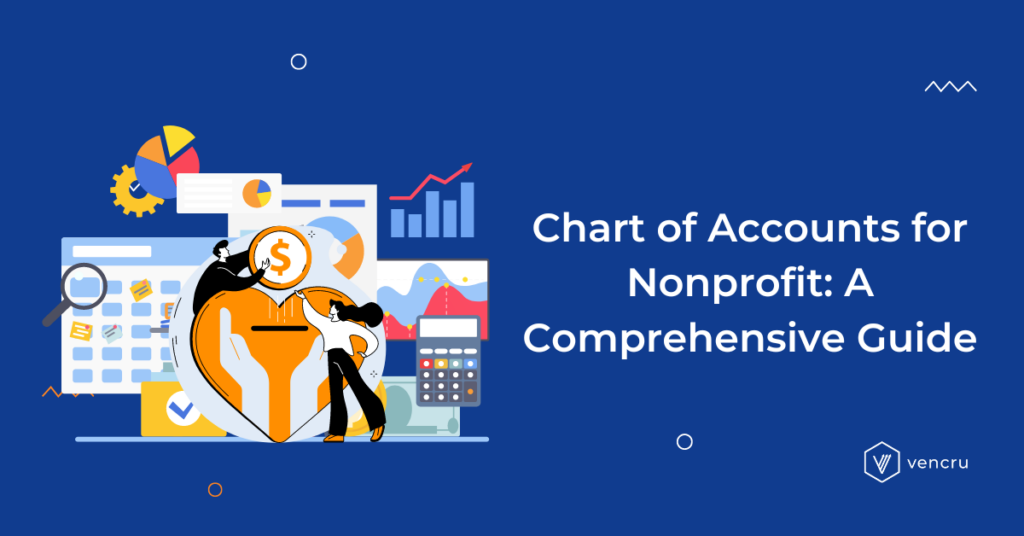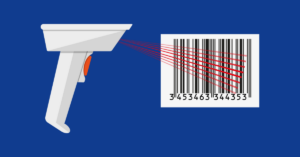Clear and accurate financial records are vital for effective management and transparency in nonprofit organizations. Understanding the nonprofit chart of accounts is an important aspect of financial management, acting as the cornerstone for organizing and documenting financial transactions. This structured list of accounts categorizes income and expenses, ensuring a clear picture of your non-profit’s financial health.
In this guide, we’ll explore the basics of the nonprofit chart of accounts, including:
- What is a Chart of Accounts for Nonprofit Organizations?
- Why is a Chart of Accounts Important for Nonprofit Organizations?
- Structuring a Chart of Accounts for Nonprofit Organizations
- Nonprofit Journal Entry Examples
- Unlock Chart of Accounts for Nonprofit with Vencru
What is a Chart of Accounts for Nonprofit Organizations?

A Chart of Accounts (CoA) for nonprofit organizations is a comprehensive listing of financial accounts used to classify and track income, expenses, assets, liabilities, and equity. It is the backbone of the financial management system of an organization, enabling accurate recording, reporting, and data analysis. Each account has a specific name and purpose, making it easy to track the flow of funds and understand your organization’s financial health.
Related Read: Chart of Accounts: Definition, examples, and industry-specific versions
Why is a Chart of Accounts Important for Nonprofit Organizations?

Nonprofit organizations have distinct financial priorities compared to for-profit businesses. Although they don’t pursue profits, they still must manage finances effectively to sustain operations and further their mission. The Chart of Accounts (CoA) is vital in this endeavor. Here’s why having a CoA is crucial for your nonprofit:
- Financial Transparency: Donors, grantors, and stakeholders expect transparency and accountability in how nonprofits manage their funds. A well-maintained Chart of Accounts facilitates transparency by creating an audit trail, allowing you to trace financial transactions and providing clear insights into the organization’s financial health.
- Strategic Decision-Making: Nonprofit leaders rely on financial data to make informed decisions about resource allocation, program expansion, and fundraising strategies. A robust Chart of Accounts ensures that financial information is readily available and easily accessible for decision-making purposes.
- Compliance and Reporting: Nonprofits are subject to various legal and regulatory requirements, including financial reporting standards and tax regulations. An accurate and up-to-date Chart of Accounts ensures compliance with these requirements and facilitates nonprofit accounting i.e. the preparation of financial statements and reports.
- Resource Allocation: Nonprofits often operate with limited resources and must allocate them wisely to achieve their mission. A well-structured Chart of Accounts helps nonprofits track their income and expenses, identify areas of inefficiency or overspending, and optimize resource allocation for maximum impact.
Structuring a Chart of Accounts for Nonprofit Organizations
When structuring a Chart of Accounts for a nonprofit organization, it’s essential to consider its unique financial needs and reporting requirements. Here’s a sample framework for structuring a Chart of Accounts:

Asset Accounts
| Account Number | Account Name | Description |
|---|---|---|
| 101 | Cash and Cash Equivalents | Represents the organization’s liquid assets, including cash on hand and funds in bank accounts. |
| 102 | Investments | Funds invested for future use or to generate income, such as stocks, bonds, or other securities. |
| 103 | Property and Equipment | Records tangible assets owned and used in the non-profit’s operation such as land, buildings, vehicles, and equipment. |
| 104 | Prepaid Expenses | Captures expenses paid in advance that will be recognized as expenses in future accounting periods. |
| 105 | Inventory | Supplies or materials used in programs or for fundraising activities (if applicable). |
| 106 | Accounts Receivable | Money owed to the non-profit by donors, program participants, or other entities. |
Liability Accounts
| Account Number | Account Name | Description |
|---|---|---|
| 201 | Accounts Payable | Represents amounts owed by the organization to suppliers, vendors, or creditors. |
| 202 | Accrued Expenses | Tracks expenses that have been incurred but not yet paid, such as utilities or salaries. |
| 203 | Loans Payable | Records outstanding loans or debts that the organization owes to external parties. |
| 204 | Deferred Revenue | Captures funds received in advance for goods or services that will be provided in the future. |
| 205 | Salaries Payable | Wages owed to employees but not yet paid. |
Equity Accounts
| Account Number | Account Name | Description |
|---|---|---|
| 301 | Unrestricted Net Assets | Represents funds that are not subject to donor-imposed restrictions and can be used freely for any charitable purposE. |
| 302 | Temporarily Restricted Assets | Tracks funds with donor-imposed restrictions that will be released upon the occurrence of a certain event or timeframe. |
| 303 | Permanently Restricted Assets | Records funds with donor-imposed restrictions that must be retained indefinitely, such as endowment funds. |
Revenue Accounts
| Account Number | Account Name | Description |
|---|---|---|
| 401 | Donations and Contributions | Captures funds received from donors and supporters, including individual donations and grants. |
| 402 | Grants and Contracts | Records funds received from government agencies, foundations, or other entities for specific projects or programs. |
| 403 | Program Fees | Represents revenue generated from program fees charged to beneficiaries or service recipients. |
| 404 | Investment Income | Tracks income earned from investments, such as dividends, interest, or capital gains. |
| 405 | In-Kind Donations | Value of donated goods or services. |
Expense Accounts
| Account Number | Account Name | Description |
|---|---|---|
| 501 | Salaries and Benefits | Records expenses related to employee compensation, including salaries, wages, and benefits. |
| 502 | Program Expenses | Captures expenses directly associated with delivering programs or services to beneficiaries (e.g., staff salaries, program materials). |
| 503 | Administrative Expenses | Tracks general administrative expenses, such as office rent, utilities, and office supplies. |
| 504 | Fundraising Costs | Represents expenses incurred to raise funds for the organization, such as event costs or marketing expenses. |
Nonprofit Journal Entry Examples
To demonstrate how to record journal entries for a nonprofit organization, we will use three examples:
1. Recording a Donation
- Scenario: A generous donor contributes $5,000 to your non-profit’s general operating fund.
- Journal Entry:
| Account | Debit | Credit | Description |
|---|---|---|---|
| Cash and Cash Equivalents | $5,000 | To record the cash donation received. | |
| Donations and Contributions | $5,000 | To record the contribution for general operations. |
Explanation:
- We debit the Cash and Cash Equivalents account for $5,000 because cash is coming into the organization.
- We credit the Donations and Contributions of $5,000 because this represents unrestricted funds that can be used for any charitable purpose.
2. Recording Program Expenses
- Scenario: Your non-profit spent $2,000 on educational materials for a youth literacy program.
- Journal Entry:
| Account | Debit | Credit | Description |
|---|---|---|---|
| Program Expenses | $2,000 | To record the cost of educational materials for the literacy program. | |
| Cash and Cash Equivalents | $2,000 | To record the cash used to pay for the materials. |
Explanation:
- We debit the Program Expenses account for $2,000 to track the cost associated with this specific program.
- We credit the Cash and Cash Equivalents account for $2,000 because cash is leaving the organization to pay for the materials.
3. Recording In-Kind Donation
- Scenario: A local printing company donates 1,000 flyers valued at $100 to promote your upcoming fundraising event.
- Journal Entry:
| Account | Debit | Credit | Description |
|---|---|---|---|
| In-Kind Donations | $100 | To record the value of the donated flyers. | |
| Inventory | $100 | To record the donated flyers used for the fundraising event. |
Explanation:
- We debit the In-Kind Donations account for $100 to track the value of the non-cash donation received.
- We credit the Inventory account for $100 to record the donated flyers as an asset used for fundraising.
Unlock Chart of Accounts for Nonprofit with Vencru
A well-organized Chart of Accounts is crucial for nonprofit organizations to handle finances efficiently, demonstrate accountability to stakeholders, and fulfil their mission. By adopting a comprehensive and strategic Chart of Accounts, nonprofits can simplify financial management, make informed choices, and amplify their impact on communities.
Vencru provides specialized accounting software designed specifically for the distinct needs of nonprofits. With functionalities like customizable Chart of Accounts, accounting, and client management, Vencru empowers nonprofits to streamline financial management processes and focus on mission-driven initiatives. Explore how Vencru can elevate your nonprofit organization today!
Ready to explore Vencru? Get started here or book a demo
Related Content:
- Guide to Retail Chart of Accounts (with sample PDF)
- Chart Of Accounts For A Construction Company: Detailed Guide
- Chart Of Accounts For E-commerce Businesses: Detailed Guide
Disclaimer: This article is for informational purposes only and does not constitute financial or legal advice. Organizations should consult qualified professionals for guidance on their specific financial management needs.









